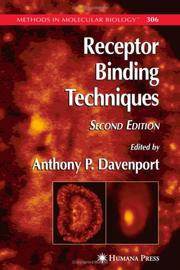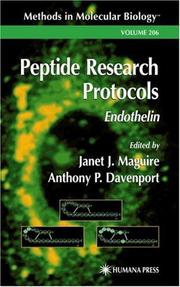| Listing 1 - 3 of 3 |
Sort by
|
Book
ISBN: 1617799092 1617799084 Year: 2012 Publisher: Totowa, NJ : Humana Press : Imprint: Humana,
Abstract | Keywords | Export | Availability | Bookmark
 Loading...
Loading...Choose an application
- Reference Manager
- EndNote
- RefWorks (Direct export to RefWorks)
A broad definition of a receptor is a specialized protein on or in a cell that recognizes and binds a specific ligand to undergo a conformational change, leading to a physiological response or change in cell function. A ligand can be an endogenous neurotransmitter, hormone, paracrine/autocrine factor, or a synthetic drug that may function as an agonist or antagonist. The third edition of Receptor Binding Techniques expands upon the methods and techniques used for studying receptors in silico, in vitro and in vivo. Comprehensive chapters describe how to use online resources for experimental research such as prediction of receptor-ligand interactions and mine the IUPHAR receptor database. Classical techniques of radioligand binding, quantitative autoradiography and their analyses are complemented by the use of immunocytochemistry for the cellular localization of receptor protein and hybridization to detect receptor mRNA. Protocols using fluorescent labeled ligands are described to visualise receptors in living cells, their interaction with beta-arrestin to measure ligand-induced internalisation and green fluorescent protein to study trafficking. Non-radioactive, chemiluminescent cAMP and arrestin assays facilitate the identification of novel ‘biased agonists’. Detailed methods are provided for in vivo imaging of receptors using positron emission tomography (PET). Written in the highly successful Methods in Molecular Biology™ series format, chapters include introductions to their respective topics, lists of the necessary materials and reagents, step-by-step, readily reproducible laboratory protocols, and key tips on troubleshooting and avoiding known pitfalls. Authoritative and practical, Receptor Binding Techniques, Third Edition, aids scientists in continuing to study receptor binding.
Biochemistry. --- RNA-ligand interactions. --- Protein Science. --- Protein-Ligand Interactions. --- Biological chemistry --- Chemical composition of organisms --- Organisms --- Physiological chemistry --- Biology --- Chemistry --- Medical sciences --- Composition

ISBN: 1280359056 9786610359059 1592599273 158829420X Year: 2005 Publisher: Totowa, N.J. : Humana Press,
Abstract | Keywords | Export | Availability | Bookmark
 Loading...
Loading...Choose an application
- Reference Manager
- EndNote
- RefWorks (Direct export to RefWorks)
Maintaining the high standards set by the successful first edition, Anthony P. Davenport and a panel of hands-on researchers from the pharmaceutical industry and academia take advantage of the latest developments to provide detailed practical methods for studying receptors in silico, in vitro, and in vivo. These readily reproducible techniques cover mining from curated databases, identifying novel receptors by high throughput screening, molecular methods to identify mRNA encoding receptors, radioligand binding assays and their analysis, quantitative autoradiography, and imaging receptors by positron emission tomography (PET). Highlights include phenotypic characterization of receptors in knock-out mice, imaging receptors using green fluorescent protein and fluorescent resonance energy transfer, and quantitative analysis of receptor mRNA by TaqMan polymerase chain reaction (PCR). These ligand binding techniques are perfect for exploring the unprecedented number of new receptor systems now emerging and the so-called "orphan" receptors whose activating ligand has not been identified. The protocols follow the successful Methods in Molecular Biology™ series format, each offering step-by-step laboratory instructions, an introduction outlining the principle behind the technique, lists of the necessary equipment and reagents, and tips on troubleshooting and avoiding known pitfalls. Comprehensive and state of the art, Receptor Binding Techniques, Second Edition offers academic and commercial researchers in the pharmaceutical and biotechnology industries a set of proven techniques for the successful characterization of receptors and the phenotyping of transgenic animals, including knock-outs.
Pharmacy. --- Chemistry --- Medicine --- Drugs --- Materia medica --- Pharmacology --- Receptor-ligand complexes --- Radioligand assay --- Cell receptors --- Research

ISBN: 1280830735 9786610830732 1592592899 0896039935 Year: 2002 Publisher: Totowa, NJ : Humana Press : Imprint: Humana,
Abstract | Keywords | Export | Availability | Bookmark
 Loading...
Loading...Choose an application
- Reference Manager
- EndNote
- RefWorks (Direct export to RefWorks)
Tantalizing new research frontiers are opening in peptide research, where the endothelins constitute an important class of signals that can be manipulated therapeutically to treat cardiovascular disease. In Peptide Research Protocols: Endothelin, a panel of multidisciplinary experts describes in detail readily reproducible methods to investigate all aspects of peptide research by focusing on the endothelin system-from its synthesis and metabolism, to its function in health and disease. These methods use state-of-the-art molecular techniques to quantify the expression of mRNA, here using both endothelin receptors and the endothelin-converting enzymes. They show how peptides, precursors, receptors, and synthetic enzymes can be localized and quantified in plasma, culture supernatants, tissue homogenate, and tissue sections using antibodies, and how radioligand binding techniques can provide additional information on receptor characterization. In vitro assays are presented to determine the function of peptides in isolated preparations, to characterize new receptor ligands, and to provide information on the tissue-specific processing of precursor peptides-all in the endothelin system. Several in vivo protocols illustrate the role of the endothelin peptides in healthy human individuals and describe animal models that can be used to predict the therapeutic potential of cardiovascular drugs that manipulate endothelin synthesis or function. Authoritative and timely, Peptide Research Protocols: Endothelin provides both a comprehensive introduction to endothelin biology and an up-to-date collection of proven techniques and experimental strategies for use in peptide research today.
Pharmacy. --- Chemistry --- Medicine --- Drugs --- Materia medica --- Pharmacology
| Listing 1 - 3 of 3 |
Sort by
|

 Search
Search Feedback
Feedback About UniCat
About UniCat  Help
Help News
News